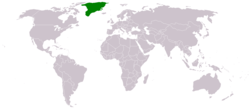Greenland
Greenland (Greenlandic: Kalaallit Nunaat; Danish: Grønland) is the world's largest non-continental island, in the far northeast of North America, largely within the Arctic Circle. Although it is still part of the Kingdom of Denmark, it was granted self-government in 1979. In 2008, it voted for more autonomy, in effect making it a separate country with formal ties to Denmark, and a member of the Nordic Council. Some inhabitants are now projecting the eventual road to full independence. Copenhagen remains responsible for its foreign affairs, and is a source of investment.
The closest neighbouring countries and territories are Iceland to the south-east, Canada to the west and the Svalbard islands of Norway to the north-east.
Regions
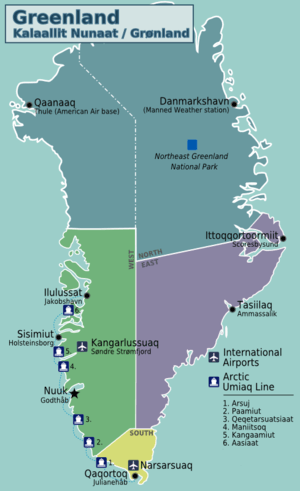
| Southern Greenland Nicknamed "Sineriak Bananeqarfik" (Banana Coast) by the locals, this is the most easily accessed part of Greenland and the one subject to the least extreme temperatures. Surprisingly, farming is common in the lower parts of the region, especially around Igaliku. Dirt roads connect the farms, and go into canyons which are within sight of snow-covered mountains and glaciers. |
| Western Greenland Location of the capital Nuuk (Godthåb), a "city" with more than 17,000 people. Much of the population of Greenland lives in this region - Nuuk alone has more than twice the population of southern Greenland. The major airport, Kangerlussuaq, is in this region. |
| Eastern Greenland Eastern Greenland has significantly fewer people than the west. The only notable towns in this region are Tasiilaq and Ittoqqortoormiit. However, the area is easily accessible on tours from Iceland, and has excellent scenery. |
| Northern Greenland Much of Northern Greenland is occupied by the Northeast Greenland National Park. It is extremely remote, much like the East, but is colder. The northernmost land on Earth is in this region of Greenland. |
Cities
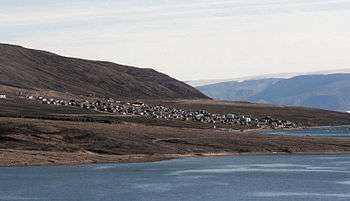
Greenlandic places generally have two names: the (traditional and now official) Greenlandic, or Kalaallisut, and the (once but no longer official) Danish. Greenlandic is abbreviated 'kl;' Danish is 'da.'
- 🌍 Nuuk (da: Godthåb) – the capital
- 🌍 Ittoqqortoormiit (da: Scoresbysund) – settlement in the sparsely populated eastern Greenland
- 🌍 Kangerlussuaq (da: Søndre Strømfjord) – known for research facilities and the former US Bluie West Eight base; comparably mild weather, while the glacier is in easy reach; good site for viewing northern lights.
- 🌍 Kulusuk (da: Kap Dan) – one of the largest towns in Eastern Greenland
- 🌍 Qaanaaq (da: Thule) – one of the world's northernmost civilian settlements, with a U.S. airbase
- 🌍 Sisimiut (da: Holsteinsborg) – second largest city
- 🌍 Tasiilaq (also Amassalik, for its municipality and the island it is on) – the largest city in Eastern Greenland
- 🌍 – unique wildlife, the largest bird cliff (Apparsuit)
- 🌍 Uummannaq – whale watchers' paradise
Other destinations
- 🌍 Northeast Greenland National Park – the largest natural reserve in the world. There are no towns or settlements, only a couple of weather stations. This area is accessible on cruise expeditions.
Understand
According to the Icelandic Sagas, Erik the Red chose the name "Greenland" to entice settlers from Iceland. In fact, Greenland has far more ice cover (about 84% of its surface area) than Iceland does, but the southern coasts the Vikings settled are green in summer, and were likely more so during the Medieval Warm Period.
Be careful with maps of Greenland, as many Greenlandic names simply reference a particular geographical feature. For example, "Kangerlussuaq" means "Big Fjord" and so is not only the Greenlandic name for Søndre Strømfjord.
When visiting a city or village don't be afraid to ask for directions of shops, places to eat or somewhere to sleep, even if you think there might not be any. Most places (even Nuuk) are small enough for everyone to know where everything is, and therefore no one bothered to put up a sign. Don't be surprised to find a fully equipped supermarket inside a grey factory-like building in the middle of nowhere.
Location
Although some maps with flat projections of the globe tend to make Greenland look the size of Africa, it is actually "only" about the size of Mexico. Greenland has the lowest population density among autonomous entities.
It represents some 97% of the area of the Kingdom of Denmark. The Danish territorial claim is rooted in the 10th-century explorations of the Vikings, though administrative power has changed hands several times over the centuries due to developments in Europe. The native Greenlanders, or Kalaallit, are Inuit descendants of nomads from northern Canada. ("Eskimo" is offensive in Canada and Greenland, but not in the USA.)
Climate
Although all of Greenland is known for being cold, different parts of Greenland have significantly different temperatures. For example, parts of Southern Greenland, have in the past reached 86 °F (30 °C); meanwhile, temperatures in the high central plateau and far north of Greenland can get as low as −87 °F (−66 °C).
Coastal regions on the northern half of Greenland experience winter temperatures similar to or slightly warmer than the Canadian Archipelago, with average January temperatures of −30 °C to −25 °C (−22 °F to −13 °F). The coastal regions in the southern part of the island are influenced more by open ocean water and by frequent passage of cyclones, both of which help to keep the temperature there from being as low as in the north. As a result of these influences, the average temperature in these areas in January is considerably higher.
The interior ice sheet escapes much of the influence of heat transfer from the ocean or from cyclones, and its high elevation also acts to give it a colder climate since temperatures tend to decrease with elevation. Snow cover, combined with the ice sheet's elevation, keep temperatures on the ice sheet lower, with July averages between −12 °C and 0 °C (10 °F and 32 °F).
In summer, the coastal regions of Greenland experience temperatures averaging just a few degrees above freezing in July, with slightly higher temperatures in the south and west than in the north and east. Along the coast, temperatures are kept from varying too much by the moderating influence of the nearby water or melting sea ice. Temperatures above 20 °C are rare but do sometimes occur in the far south and south-west coastal areas.
Get in
Passports and visas
If you do not need a visa for Denmark, you can generally visit Greenland for up to 90 days in a half year without a visa, although your passport must be valid for at least three months after your visit. Nordic citizens (Swedish, Danish, Norwegian, Finnish and Icelandic) do not need visas for any length of stay, and can use any form of identity documentation to enter. EU/EEA/Swiss citizens can use a national ID card instead of a passport.
.jpg)
If you do require a visa for Denmark, Schengen area visas issued for visits to mainland Denmark are not valid for Greenland or the Faeroe Islands. You will need a separate visa, which can be applied for at any Danish diplomatic post or embassy along with your Schengen visa for Denmark or Iceland if you are transiting through one of those countries. If you are flying through Nunavut, you would need a Canadian temporary resident or transit visa.
If you're planning work or study in Greenland, you'll need an appropriate permit, although some types of work (teaching, consulting, artists, installation technicians, and a few others) as well as short term research are exempt from needing a work/ study permit if the time spent in Greenland is less than 90 days. For more information look here.
There is no border control on entering or leaving Greenland - all document checks are performed by the airline during check-in and at the gate. Thus, if you need your passport stamped (e.g. for a residence permit) you will normally have to seek out border staff yourself or get in touch with Greenland Homerule to obtain the stamp.
Expedition permits
If you stay on the typical tourist paths you do not need any permissions, but any expeditions (including any trips to the national park, which by definition are expeditions) need a special permit from the Danish polar centre. If travelling with an agency they will usually take care of the paperwork for you. If you are entering or travelling through Thule Air Base, you also need a permission from the Danish department of foreign affairs, since it is a US military area (except for children under 15, Danish police and military, US military or US diplomats). See Qaanaaq for details.
By plane
Trans-oceanic service to Greenland either lands at 🌍 Kangerlussuaq (SFJ IATA) (Danish: Søndre Strømfjord, English: Sondrestrom), or 🌍 Narsarsuaq (UAK IATA), the only airports in the country that can accept anything larger than a turboprop. These two airports are in unpopulated areas without road connection, and almost every passenger continues with local flights, helicopters, or boats.
The capital 🌍 Nuuk (GOH IATA) is also seeing some international traffic from Iceland in the summer.
Except on the Reykjavík-Nuuk route, where there is some competition, getting to Greenland is expensive, although sometimes travel agents are able to get discounts through agreements with Greenland Tourism.
Two airlines provide scheduled service to the country:
- Air Greenland, the flag carrier, offers several options for reaching Greenland:
- Year-round, a daily return between Copenhagen and Kangerlussuaq, with a second daily return in the summer season contracted out to Danish carrier JetTime. From Kangerlussaq, you can reach any other city or settlement in the country, including the capital Nuuk, through Air Greenland's domestic network.
- Seasonally, Air Greenland has several departures each week between Copenhagen and Narsarsuaq, operated by JetTime.
- June to September, two weekly returns from Keflavik Airport in Iceland (Icelandair's hub) to Nuuk and Narsarsuaq. With plenty of flights between the United States and Iceland, this is by far the easiest way to get to Greenland from North America. It's also the most affordable as it's the only route Air Greenland has any competition on.
- Also June to September, there is twice weekly service between Iqaluit in Canada and Nuuk. Through codeshare agreements with FirstAir, it is possible to purchase a ticket originating in Ottawa (YOW) from around kr10,000 ($2,500 return).
- Air Greenland only sells tickets through its own website and travel agents. Fares are not advertised on Expedia, Priceline, or any consolidator website.
- Despite minority ownership by SAS, Air Greenland is not part of the Star Alliance network nor does it have codeshares through SAS or any other major carrier. Interlining baggage and a single reservation may be possible: consult a travel agent.
- Air Iceland operates year-round flights from Reykjavík to Kulusuk, Ittoqqortoormiit and Nuuk and additionally to Narsarsuaq and Ilulissat during the summer months. Air Iceland is not the same carrier as Icelandair. It operates out of the downtown Reykjavík airport (domestic, Greenland and Faroe Islands flights only), rather than the international airport at Keflavik, which Icelandair uses. If you arrive on Icelandair from North America or Europe, you'll need to transfer airports, and you should allow at least four hours between flights for this. The flights to Greenland typically leave in the morning and flights to Iceland in the afternoon. This means together with the transfer time that a night's sleep is probably needed In Iceland. If you are vacationing in Iceland, one popular day excursion is to fly from Reykjavík to Kulusuk, where traditional handicrafts are on sale, before returning to the comparative comforts of Iceland.
There are also many charter outfits serving Greenland from Europe and North America, and if you're on a package tour to Greenland from North America, a chartered flight is frequently included. Scientific and technical personnel travelling from North America for research purposes typically fly into Kangerlussuaq aboard New York Air National Guard C-130s.
Greenland's airports are private aviation-friendly if the weather is right. The name of Greenland's airport service is Mittarfeqarfiit.
By boat
Realistically, there is no ferry service from Europe or North America. Royal Arctic Line is the national freight operator, but they don't take passengers to or from Greenland.
There are cruise ships from both continents that visit Greenland:
- Hurtigruten, has cruises from or to Iceland.
By car
It is possible to transport a car as container cargo. Royal Arctic Line transports containers and other goods from Aalborg. This is however very expensive (kr 30,000 return) and time consuming and considering there are no roads between settlements, this is done only when moving or buying a car, not by visitors.
Get around

There is no road or rail system. The easiest way to get around Greenland is by plane, particularly Air Greenland. In the summer, Arctic Umiaq Line passenger ships provide service to destinations between Narsarsuaq and Uummannaq along the west coast. Royal Arctic Line can take passengers on local routes.
See
- Icebergs and glaciers (especially the Ilulissat Icefjord)
- Animal life - Whales, seals, walruses, musk oxen, reindeer/caribou and polar bears; see North American wildlife.
- The Midnight sun - In the northern 2/3 of Greenland, the sun stays above the horizon for days or even several weeks in the summer. In the remainder, the weeks around the summer solstice (21 June, a national holiday) see the sun dip below the horizon for only a short while each night, with the sky never getting truly dark. (Of course the reverse is true in the winter.)
Do

Hiking
You can freely hike near most settlements in Greenland as there is no property ownership anywhere in the country. Do go off the few small walking paths that exist. You will easily find yourself in offbeat locales, and wonder if you are perhaps the first person to ever stand in that particular spot. This rare sensation is by far the best reason to travel in Greenland.
Hiking does require permits in some cases, though. The government requires expedition permits for all traffic on the glacier, in the Greenland National Park and East Greenland except areas around Illoqqortoormiut and Tasiilaq. There is a non-refundable application fee of kr 4000 for the expedition permit.
There are hiking trails or trail networks in some parts of Greenland.
Driving a dog-sled
Kayaking
Mountaineering
As with hiking, you need permits for some destinations. The helicopters on Greenland are not equipped for mountain rescue.
Talk
The official language - Greenlandic (Kalaallisut) - is that of the more populated western coast. The eastern dialect is slightly different. Both are highly challenging languages to learn, as words are very long and often feature "swallowed" consonants. Try uteqqipugut or Ittoqqortoormiit on for size.
The good news is that almost all Greenlanders are bilingual Danish speakers, and many will even have a functional command of English. Greenlandic words may come in handy for travellers wanting to experience the "real Greenland", though.
Greenlandic is different enough from Inuktitut, the language of the Canadian Inuit who share similar historical roots to the Greenlanders, that the two peoples have difficulty understanding each other. However, attempts are being made to unify the Inuit language, and Greenlandic – with its existing libraries of translated Shakespeare and Pushkin – seems the most useful option.
Buy
Money
|
Exchange rates for Danish kroner As of January 2019:
Exchange rates fluctuate. Current rates for these and other currencies are available from XE.com |
Like the rest of the Kingdom of Denmark, the official currency is the Danish krone (plural, kroner), denoted by the abbreviation "kr" (ISO code: DKK). Icelandic króna, euros, and Canadian dollars are sometimes accepted in tourist areas (but always check first), exchange other major currencies (such as pounds sterling, Swiss francs or U.S. dollars) for kroner at any bank or post office for a minimal charge.
Shopping
Greenland is largely a cash economy. With improvements to the infrastructure over the past few decades, the number of merchants accepting credit or debit cards are steadily growing, although many still do not. As a general rule, unless you're dealing with hotels or mainland chains with a presence on the island (e.g. supermarkets) don't automatically expect that credit cards are accepted: carry some cash as a backup. Every settlement has at least one ATM and if all else fails, banks may be able to give you a cash advance from your credit card.
Tourists to Greenland sometimes buy:
- Inuit art and crafts
- Sealskin - which the Great Greenland fur company has fashioned into everything from coats to thick belts to purses and pencil cases.
- Duty-free - most flights land at Kangerlussuaq, one of those lovely places on earth where you can buy duty-free after landing. Stock up on cheap booze, smokes and everything else at prices far lower than the rest of Greenland. Greenland is not a member of the EU, so although you may be travelling from Denmark, the custom rules are the same as for a trip out of the EU.
Supermarkets
These are the names to look for, if you need to buy groceries:
- Pilersuisoq - Chain of larger supermarkets usually found in small villages. Has a little bit of everything.
- Pisiffik - Chain of larger supermarkets present in the cities.
- Spar - Dutch supermarket chain with a few shops in Greenland.
- Brugsen - Danish supermarket chain with a few shops in Greenland.
Eat
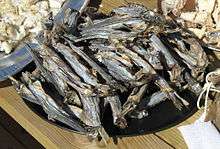
Food in Greenland is generally not that different from American or continental European tastes. Restaurants carry typical European fare. Local food can be purchased at local markets in each town. Many Greenlandic restaurants combine traditional foods (locally-caught fish, shrimp and whales; also muskox and reindeer) with more familiar dishes. Expect to find whale meat at a Thai restaurant and caribou in a Chinese joint. Nuuk also has several burger bars and a couple of very high-end restaurants, most notably Nipisa, which specializes in (very expensive) local delicacies. Prices are high everywhere, but servings are generally large, especially with fries.
Drink
A local specialty is Greenlandic coffee. Its creation in some places is pure performance and it hits hard: its coffee laced with liberal amounts of kahlua, whisky and Grand Marnier. One of the best places to buy is at the Sukhumvit Thai Restaurant, for about Canadian $22.
Sleep
Accommodations in Greenland tend to be pricey, world class hotels exist in all of the more visited areas (Hotel Hans Egede in Nuuk, Hotel Arctic - with its igloo rooms - and Hotel Hvide Falke in Ilulissat), but cheaper options exist. Try for the Seaman's Home hotel in Maniitsoq, Nuuk, Qaqortoq, Sisimiut and Aasiaat.
For less expensive options, you can check with the Nuuk Tourism office for its hostel program, where locals have rooms they will rent out for a third the price of the town's hotels. It's a great way to experience the real Greenland, although knowing a few words of Danish or Greenlandic is very helpful as your hosts may or may not understand English. You can also camp in any field or plain for free if you're equipped to handle the elements.
Learn
- 🌍 University of Greenland (in Nuuk). Most courses are in Greenlandic or Danish, but there is a very limited selection of English language courses available
Work
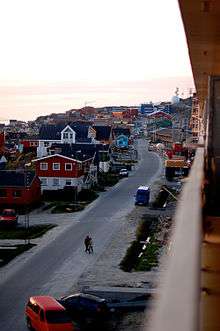
Skilled workers (K-12 teachers and doctors in particular) are always needed, knowledge of Danish or Greenlandic (preferably both) are necessary, although the University of Greenland in Nuuk does offer some programs in English. Foreigners, including most EU/EEA nationals (Greenland is not part of the EU/EEA) require a work permit in advance, which needs to be vetted and approved both by the Danish immigration authorities and the Government of Greenland. Danish citizens and other nationals of the Nordic Passport Area (Norway, Sweden, Finland, and Iceland) are exempt. Certain types of short-term work (teaching, performing, installation technicians, construction, among others) for less than 90 days does not require a work permit, nor does short-term research. See this page.
If you have residency (permanent or temporary) in Denmark, you do not have any automatic immigration privileges in Greenland, although you can visit for up to 90 days without a visa even if you are a citizen of a country that would normally require one. Under Danish immigration law, time spent in Greenland is considered time outside of Denmark for residence permit purposes, and a long visit or work assignment in Greenland (i.e. 6 months or more) could cause your permit to lapse. Contact the immigration department if this may apply to you. (For purposes of applying for Danish citizenship, time spent in Greenland fully counts as it is part of the Kingdom of Denmark.)
Stay safe
Crime, and ill-will toward foreigners in general, is virtually unknown in Greenland. Even in the towns, there are no "rough areas." So long as the visitor uses basic common sense and etiquette, he or she should be fine.
Cold weather is perhaps the only real danger an unprepared traveller will face. If you visit Greenland during cold seasons (considering that the further north you go, the colder it will be), it is essential to bring coats and warm clothes in general.
Stay healthy
The very long days in the summer can lead to problems getting sufficient sleep and associated health issues.
During the summer, also watch out for the Nordic mosquitoes. Although they do not transmit any diseases, they can be irritating.
The availability of emergency health care is limited in smaller communities. Evacuation by helicopter or airplane might be needed. This is quite expensive, so make sure you have travel appropriate insurance.
Tap water is drinkable.
Cope
Media
Newspapers
Radio
- Kalaallit Nunaata Radioa (Radio Greenland) broadcasts one national radio station with a wide variety of news, music, cultural, and entertainment programs, primarily in Kalaallisut (Greenlandic) but some features (particularly news) are also in Danish.
- In Nuuk only, a second frequency re-broadcasts Danmarks Radio from Copenhagen.
Television
- Kalaallit Nunaata Radioa broadcasts KNR TV nationwide, with a similarly broad selection of programs in both Greenlandic and Danish.
- Many settlements have a secondary commercial television station - such as Nuuk TV and Sisimiut TV with locally produced news, current affairs and entertainment programs.
- Nuuk TV also offers Nuuk TV Digital an encrypted over the air digital network available by subscription. 40 channels are available, comprised of Danish terrestrial networks (DR Television), Canal+ movie channels, and several Danish and international cable networks, such as CNN, and Discovery. If you're staying in Nuuk and your hotel or guesthouse has Nuuk TV digital, some of these channels are in English.
- Terrestrial TV networks do not broadcast around the clock. KNR Television has a breakfast news program from 06:00-11:00, closes down until 16:00 and then signs back on for the evening program until 00:00 or 01:00, hours are expanded slightly on weekends and may be expanded further for football or other sports coverage. The local commercial stations only broadcast in the evening. Nuuk TV Digital, however, is on the air 24 hours a day.
Respect
As mentioned above, though the word "Eskimo" remains acceptable in the United States, it is considered pejorative by many non-U.S. Arctic peoples, especially in Canada. While you may hear the word used by Greenlandic Natives, its use should be avoided by foreigners. The native inhabitants of Greenland call themselves Inuit in Canada and Kalaalleq (plural Kalaallit), a Greenlander, in Greenland.
Connect
Phones
Greenland has country code 299. Tele-post Greenland is the only telephone operator. Almost every village has mobile phone coverage. The countryside has much less coverage. Greenland does not belong to the EU, and the roaming charges are much higher than they are inside EU for EU residents, closer to the high end of the world's roaming prices.
Internet
Thanks to undersea fiber optic cable links to Europe and broadband satellite, Greenland is well connected with 93% of the population having internet access. Your hotel or hosts (if staying in a guesthouse or private home) will likely have wifi or an internet connected PC, and all settlements have an internet cafe or some location with public wifi. Ask around if you need help finding it.
